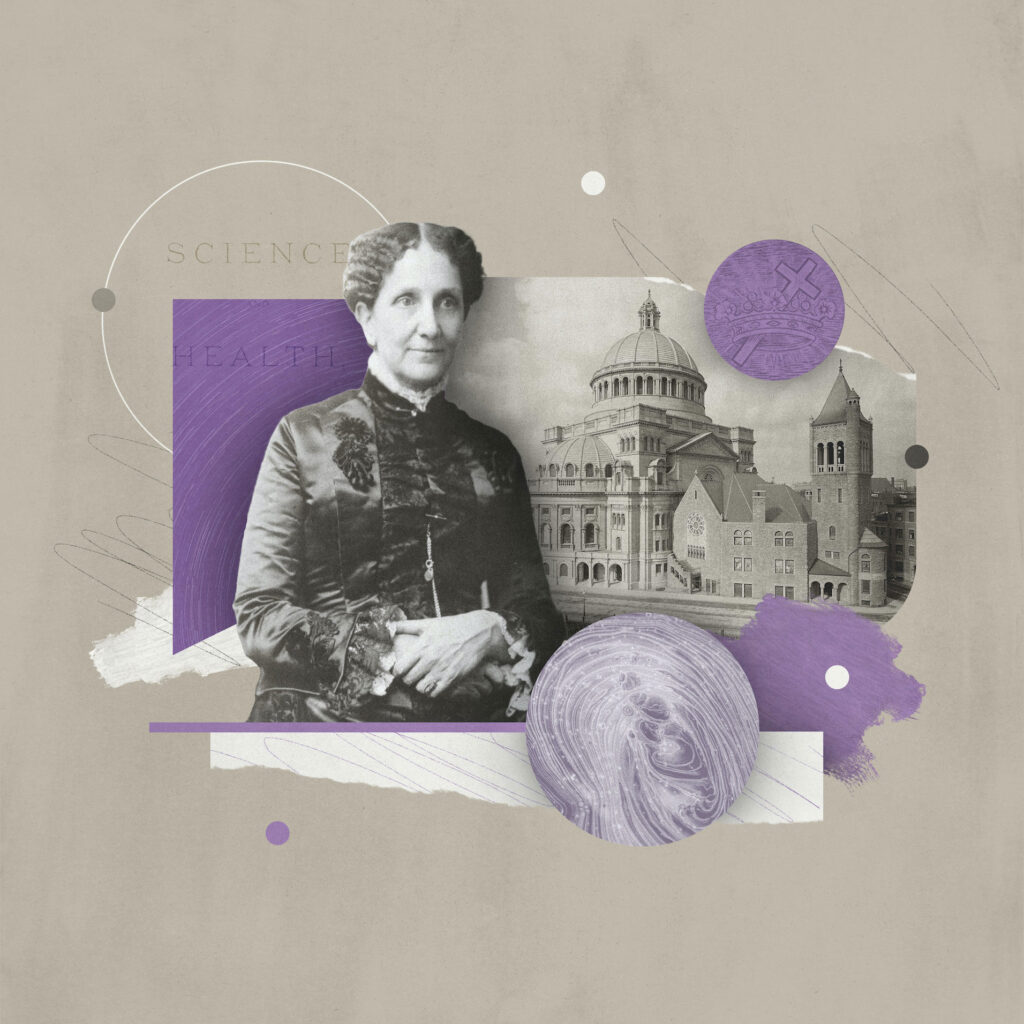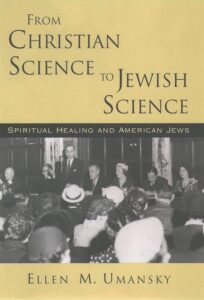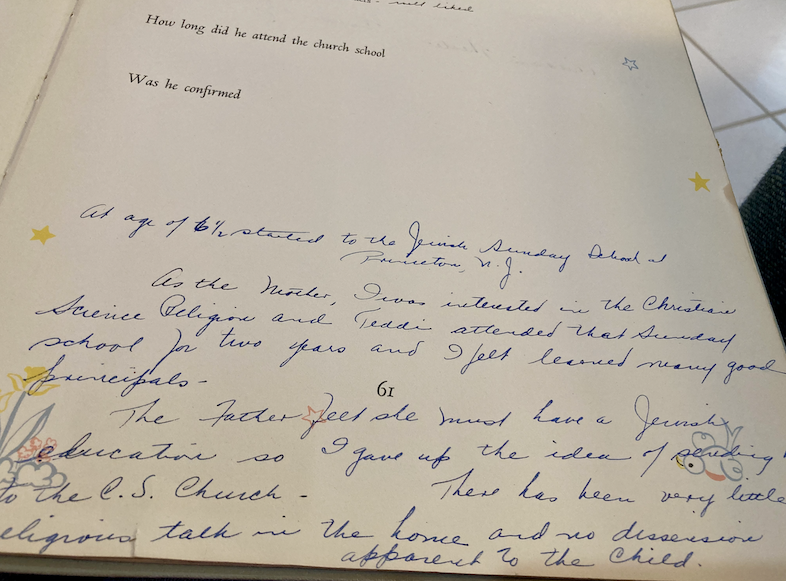Christian Science as Jewish Tradition
Why did so many American Jewish women find Christian Science appealing?

(Image of Mary Baker Eddy. Image source: ligonier.org/)
“It’s a good religion,” my grandmother liked to say to her daughter, my mother. Grandma Raedina was Jewish, as were all my relatives on both sides of the family. But in this case the religion she was touting wasn’t Judaism. It was Christian Science.
The connection between Jews and Christian Science has mostly been forgotten. But my grandmother’s flirtation with Christian Science wasn’t unusual. In the early years of the 20th century, a substantial number of Jewish Americans, especially Jewish women, joined Christian Science churches, sometimes abandoning Judaism, but more often just adding Christian Science to their Jewish identities.
Jewish institutions and Jewish leaders have not been especially interested in discussing, much less celebrating, the connection between Judaism and Christian Science. Growing up, my mom occasionally mentioned that my grandmother had been interested in Christian Science. I had only the vaguest idea of what Christian Science was, and no way to know that it had attracted many Jews, not just Grandma Raedina. Christian Science seemed like my grandmother’s individual personality quirk, rather than an expression of a social trend, or of a certain kind of Jewish identity.
I only started thinking about my family’s relationship to Christian Science in the last few years, and especially in the last few months. Like many Jewish people in the United States, I’ve been forcibly reminded of how central Zionism is to American Jewish life. I’ve also been reminded of how alienating I find that centrality. I’ve never identified strongly with Israel, and to me its current actions in Gaza are unconscionable. My relatives were virtually all in the United States long before Israel existed—experimenting with Christian Science in some cases.
I can’t say I identity strongly with Christian Science either; I’m not much for faith healing. Finding alternatives to Zionism in Jewish life, though, means taking diaspora seriously, and that means finding a way to talk about assimilation, syncretism, and heterodoxy that doesn’t begin and end with disavowal. I don’t want to be a Christian Scientist. But I’ve been trying to find out why many American Jewish women like my grandmother, at least intermittently, did.
My Jewish Christian Scientist Ancestors
Christian Science was founded in the United States in 1879 by Mary Baker Eddy. Eddy believed the physical world was essentially an illusion, created by the weakness of the human mind. Therefore illness and misfortune were a kind of unreal human projection. Through faith and prayer, Christian Scientists could cast aside the illusion of sickness and reestablish the real, authentic truth of health. Christian Scientists generally embraced faith healing, and often (though not always) refused to see traditional doctors.
 How many Jewish people turned to Christian Science? Exact numbers are difficult to come by, but at the height of Christian Science’s growth in the early 20th century, the number of Jewish adherents was probably in the thousands, and may have numbered as many as 40,000, according to Ellen M. Umansky’s 2005 monograph From Christian Science to Jewish Science: Spiritual Healing and American Jews. Even if Umansky’s highest estimate is accurate, Jewish converts to Christian Science involved at most 0.5 percent of the 3 million Jews living in the U.S. in the 1910s. Nonetheless, the rapid rise of Christian Science at the time alarmed many Jewish observers.
How many Jewish people turned to Christian Science? Exact numbers are difficult to come by, but at the height of Christian Science’s growth in the early 20th century, the number of Jewish adherents was probably in the thousands, and may have numbered as many as 40,000, according to Ellen M. Umansky’s 2005 monograph From Christian Science to Jewish Science: Spiritual Healing and American Jews. Even if Umansky’s highest estimate is accurate, Jewish converts to Christian Science involved at most 0.5 percent of the 3 million Jews living in the U.S. in the 1910s. Nonetheless, the rapid rise of Christian Science at the time alarmed many Jewish observers.
One of the Jews who embraced Christian Science was my great grandmother, Hattie Davidson. Born in the U.S. in 1887 to Samuel Davidson, a Lithuanian Jewish immigrant, and Sarah Masser, who immigrated from somewhere in Eastern Europe, Hattie was the eldest of eight siblings. Hattie’s husband Abe Davidson, a tailor and milliner, was born in Suwalk, Russia in 1883 and came to the U.S. 18 years later. The two met in Chicago, where Hattie grew up, and married in 1910. Raedina was born two years later, when Hattie would have been 25.
Hattie, according to family lore, was beautiful, intelligent, and for most of her life, very unhappy. She attended business school but rarely worked outside the home except for a short stint in an office job during World War II. She loathed housework and didn’t seem to like her marriage either. She stayed with my mother’s parents towards the end of her life in the early 1960s, and my mother remembers her as cranky and miserable, though that could have been in part due to her worsening health.
Why Christian Science?
Exactly how and when Hattie became involved in Christian Science is unclear. Since her sisters were also adherents, it’s possible that their mother introduced it to them when they were children.
Contemporary Jewish observers in the 1900s suggested that Jews were attracted to Christian Science as a way of assimilating and shedding the stigma and antisemitism associated with Jewish identity. Umansky quotes a hostile 1913 editorial in the American Hebrew which insists that Christian Science for Jews was a “fashionable fad adopted” by Jewish people because of its “social element.” In other words, Jewish people joined because the church allowed for upward mobility.
The transition to Christian Science was relatively easy in comparison to conversion to other Christian denominations. Christian Science didn’t require baptism, didn’t make much of the iconography of the cross, and didn’t have traditional clergy. As a new form of Christianity, it also didn’t have painful or historical associations with antisemitism: Christian Scientists had not burned and beaten Jews in Russian or Lithuanian pogroms. The emphasis on spirituality and healing allowed some Jewish people to convince themselves that Jesus wasn’t really central to the faith—though in fact Mary Baker Eddy’s devotion to Jesus pervaded Christian Science worship, and the church required members to forswear previous congregational affiliations, including to Jewish synagogues.
Christian Science, then, was a relatively painless way to negotiate a less Jewish identity that might be more acceptable in a society controlled by Christians. Umansky argues, though, that the emphasis on social climbing and assimilation has been overstated. “I have yet to find a letter, essay, or general testimonial that cites the social aspects of membership as the major reason, much less the sole reason, for joining Christian Science,” she wrote.
Instead, Umansky argues, most American Jews joined because they were attracted to Christian Science’s spirituality. In the United States, Orthodox synagogues often focused on ritual, while Reform synagogues centered social justice community work and ethics. Both struggled to address individual religious yearnings—at least according to Jewish leaders themselves.
Umansky quotes Rabbi Max Heller, who, in 1912, argued that “our pulpits and our religious schools lay too much stress on knowledge and conduct, too little on the spirituality that must underlie a mellowing atmosphere of strong faith.” Reform Rabbi Stephen Wise of New York City’s Free Synagogue in a 1920 sermon suggested that “the inadequate spiritual character of the synagogue” had led to “a very real spiritual hunger and unrest.”
That hunger and unrest could be particularly acute among women. Umansky believes that some two-thirds of the Jews who embraced Christian Science were women, and the disproportionate appeal isn’t hard to explain. The first American woman rabbi wasn’t ordained until 1972; women in Judaism in the early 20th century were expected to take a secondary role in the leadership and study of the tradition.
In contrast, Christian Science was founded by and led by a woman. It focused on lay leadership, and these lay leaders could be of any gender. Eddy emphasized a vision of God as mother, as well as father. A woman like Hattie Davidson, who chafed at the gendered expectations of domestic work and felt stifled by her marriage, might well have felt like Christian Science offered her a recognition and status that Judaism did not.
The appeal of Christian Science to Jewish women was so prominent that some Jewish leaders came together to create “Jewish Science,” a short-lived attempt to adapt Christian Science’s spiritual concerns and faith healing to a more exclusively Jewish context. They hoped this would keep more Jewish women within the fold. The practice never became very popular, though Umansky argues that it played a role in encouraging American Jewish rabbis to embrace more fully a role as spiritual counselors. It’s notable, too, that the first Jewish American woman to serve as leader of a congregation was Tehilla Lichtenstein, a practitioner of Jewish Science.
In addition to more space for women leaders, Christian Science’s promise to cure illness was probably appealing to Jewish women like Hattie. Hattie’s breathing troubles, diagnosed as emphysema, seem to have lasted much of her life, and doctors didn’t offer much relief. Her sister, Evelyn, had even worse emphysema, and was an even more devout Christian Scientist. My mother told me that Evelyn’s death may have been hastened by her refusal to see doctors—though her Christian Science commitments may have also been strengthened by the fact that the medical science of her day couldn’t help her.
Christian Scientist No More. Mostly.
Christian Science’s growth slowed in the 1930s and 40s and declined thereafter, both among Christians and among Jews. The increasing efficacy of modern medicine, and disillusionment with the failures of faith healing may have played a role; greater opportunities for women in other denominations may have made Christian Science less attractive as well. In any case, Hattie’s children didn’t follow her into Christian Science. Raedina, my mother’s mother, married Milton Weinberger, an engineer and later a patent attorney, in 1935. While the family was not exactly devout, my mother, her sister, and her brother were raised Jewish.
Or mostly raised Jewish. Raedina was still interested in Christian Science and sent my mother, Theodora (or Teddi), to a Christian Science Sunday school circa 1947-48. “I felt [Teddi] learned many good principles” at the school, Raedina wrote in my mother’s baby book.

(Image: A note in the author’s mother’s baby book)
Eventually my grandfather put his foot down, and insisted that Teddi “must have a Jewish education,” as Raedina put it, though she added that, “There has been very little religious talk in the home.”
Still, Christian Science and its various meanings—assimilation, Americanization, spirituality—continued to hover around the edges of my family’s Jewish experience. My mom told me, to my surprise, that she had celebrated Christmas as a child—a fairly common tradition among German Jewish families, though less so among Eastern European Jews like my family. Raedina also successfully pushed Milton to change their last name; “Weinberger” was identifiably Jewish, and she felt it hindered his advancement as an army engineer, and later outside the service as a patent attorney.
Raedina would visit doctors, though she didn’t like it (who does?). She retained her skepticism towards modern medicine to her death in 2010 at the age of 98. She also held onto her mother’s Christian Science Bible, which included tabs collating passages related to Mary Baker Eddy’s teachings. “This Bible belonged to my mother,” Raedina wrote in a note to my aunt. “It is a very good one which I hope you will keep.”
Sunday School and family Bibles notwithstanding, I had never heard my mother or her siblings express much personal interest in Christian Science. So I was startled to find out that my mother had, in fact, attended at least a couple of Christian Science services as an adolescent. “I had this period where I was looking for something, I guess, more spiritual,” my mom told me. As part of her brief (and long since abandoned) quest for religious sustenance, she started attending other religious services. She had a Lutheran boyfriend, so she went to a Lutheran service. She went to a Catholic mass. She went to a Quaker meeting. And she had a friend who was a fairly devout Christian Scientist, so she went and prayed with the Christian Scientists.
What Kind of Christian Scientist Are You, Anyway?
My mother did not become a Christian Scientist, nor did she marry a Lutheran. Our family didn’t celebrate Christmas, and I went to Hebrew school and Jewish summer camp and activities at the Jewish Community Center in Northeastern Pennsylvania, where we grew up. Then I married a (very nominally) Christian woman, and my Jewish practice largely ceased to exist. My daughter didn’t go to temple or Hebrew school. At this point, even my parents don’t attend temple—not even for the High Holy Days.
Like many Jews in the U.S. and around the world, we’re a secular bunch—which makes my mother’s adolescent effort to find a more spiritual home a bit disorienting for me. Her sampling of various religions, though, is very American—and I think, in its way, very Jewish too.
Jewish people have spent a lot of our history living among others who aren’t us. Sometimes living among people who aren’t you means pogroms; sometimes it means turning inwards to preserve your culture and history. And sometimes it means learning from the people standing next to you.
Robert Zimmerman (better known as Bob Dylan) decided blues musician Blind Lemon Jefferson meant more to him than klezmer clarinetist Dave Tarras. Raedina, my grandmother, taught tap dance into her 90s to senior citizens of various ethnic backgrounds; it never bothered her that tap has African-American and Irish American roots and little to do with Judaism. Lots of New York Jews decided that Chinese food was the best Christmas tradition. My mom dated a Lutheran and went to pray with him because she was curious about how Lutherans pray.
Jewish people have always been wary of assimilation; no rabbi is going to be sanguine about their congregation rushing off to follow Mary Baker Eddy through the back door to Jesus. As Shaul Magid has pointed out, many Zionists have seen Jews in the diaspora as weak, diseased, and sickly, and as evaporating through assimilation—a stereotype that fits uncomfortably onto someone like Hattie, seeking out a quasi-Christian cure for illness. My family’s experiments with Christian Science seem to confirm all of these worries and aspersions. Are you even really still Jewish if you’re celebrating Christmas, passing on Christian Bibles, and sending your child to learn Christian Science principles?
You can certainly frame these explorations and vacillations as a kind of betrayal if you want. You could also, though, see it as one way of getting to know your neighbors, which can also be a way of getting to know yourself. Diaspora (or at least one form of diaspora) is curious, syncretic, welcoming, and not especially judgmental. It sees Judaism not as a proscriptive test designed to keep some people out, but simply as what Jewish people do—which can include covering blues songs, tap dancing, erecting a Christmas tree, embracing Buddhism, and for some significant number of Jewish women in the early 1900s, exploring Christian Science. As my grandmother might say, the diaspora is a good religion. I’m grateful she passed it down to us.
Noah Berlatsky is a freelance writer in Chicago. He writes about culture, politics, music and other subjects at his substack, Everything Is Horrible.